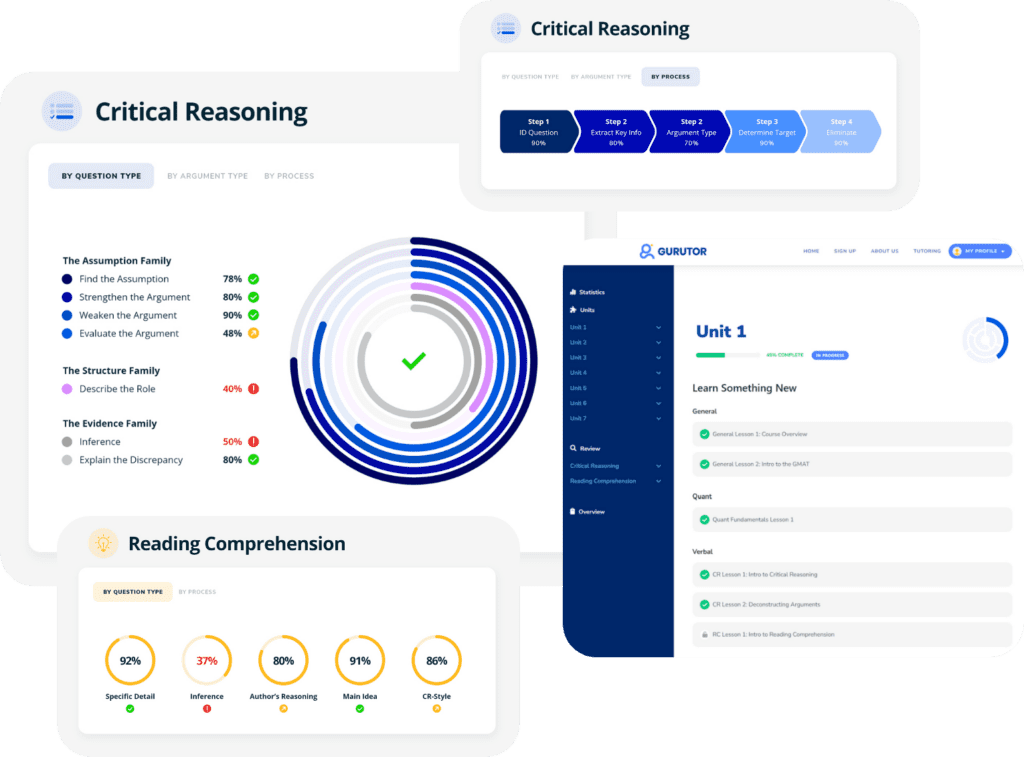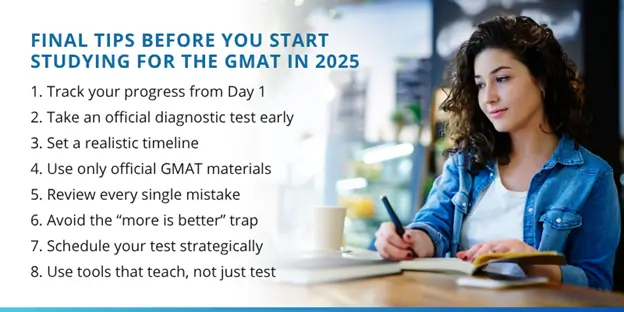How to Start Studying for the GMAT in 2025

Preparing for the GMAT in 2025?
The GMAT isn’t just a test of content; it’s a test of how you think. And with the GMAT Focus Edition now in effect, that’s more true than ever.
Launched in 2024, the Focus Edition focuses on just three sections:
- Quantitative Reasoning
- Verbal Reasoning
- Data Insights
But make no mistake: it’s still designed to test how you process information, make decisions under pressure, and reason through unfamiliar problems.
So if you’re wondering how to start studying for the GMAT, forget the old playbook. You need a smarter plan, one built around structure, strategy, and continuous feedback. This guide walks you through exactly that.
Understand What’s on the 2025 GMAT
The GMAT Focus Edition is designed to test only what matters: reasoning, analysis, and decision-making, including three sections:
- Quantitative Reasoning
- Verbal Reasoning
- Data Insights
Plus, the GMAT Focus Edition uses an updated score scale and introduces individual section scores, making your performance more transparent and easier to interpret, for both you and admissions teams.
- Total Score Range: 205–805
- Section Scores (Quant, Verbal, Data Insights): 60–90 each, weighted equally.
Compared to the classic GMAT (10th Edition), the Focus Edition is not just shorter, it’s smarter.
Here’s a comparison of classic GMAT vs. the Focus Edition:
| Feature | Classic GMAT (10th Ed.) | GMAT Focus Edition |
| Total Sections | 4: Quantitative, Verbal, Integrated Reasoning (IR), AWA | 3: Quantitative Reasoning, Verbal Reasoning, Data Insights |
| Test Duration | 3 hours 7 minutes | 2 hours 15 minutes |
| Writing Section | AWA included | Removed from the GMAT exam |
| Integrated Reasoning | Scored separately (scale 1–8) | Replaced by Data Insights (60–90 score integrated into total) |
| Sentence Correction | Yes, part of Verbal section | Removed entirely |
| Geometry Questions | Yes, within the Quant section | Removed; focus is now on problem-solving only |
Take a Diagnostic Test
Before you dive into content or build a schedule, take a diagnostic test.
This single step saves weeks of unfocused prep.
Your baseline score tells you exactly where you stand and which areas need the most attention.
Here’s how to do it right:
- Use official sources only: GMAC or MBA.com. These free tools are the closest to the real exam and will provide you with realistic data.
- Don’t prep before the diagnostic: You want a raw snapshot of your current ability.
- After the test, don’t just look at the score, break it down: Which question types slowed you down? Where did accuracy drop? What felt unfamiliar?
- Use the results to prioritize, not panic: Weak areas become your first study zones.
This is the fastest way to build a prep strategy that’s efficient and focused on score improvement, not busywork.
Set a Realistic Timeline
Your GMAT prep doesn’t need to take forever, but it does need to be structured around your target score, current skill level, and available time.
Here’s how to plan it with intent:
- If you’re aiming for a competitive score (685–725), most students need 3 to 4 months of consistent prep.
- If your goal is 725+, plan for 4 to 6 months, as that level requires not just knowledge, but also speed and adaptability across all sections.
For example, consider the following time commitments:
- Working professionals
Aim for 8–12 focused hours per week. That typically means weekday evenings + 1 weekend block.
You won’t make daily progress, so your plan needs to be airtight.
- Full-time students or those with flexible schedules
You can complete your preparation in 2–4 months with 12–15 hours of work per week. However, volume without strategy leads to burnout; thus, stay efficient.
Remember, high scorers aren’t the ones who study the most hours; they’re the ones who study the right things at the right time.
A good prep timeline builds in:
- Early diagnostic + analysis
- Focused weekly targets tied to weak areas
- Full-length practice exams every 2–3 weeks
- Time for feedback, review, and improvement
Remember, the GMAT is a reasoning test, not a memorization contest. Your timeline should reflect that.
Gather the Right Study Materials
Creating a study plan and choosing the right materials is where GMAT prep begins.
Here’s a list of study materials to start your GMAT exam prep:
- GMAT Official Starter Kit (Free):
- 70 + real GMAT questions across all three Focus Edition sections
- Two full-length practice exams using the real scoring algorithm
- Guided study plan and performance insights to kick off your prep
- Free resources: GMAC’s mba.com offers free tools like a 6-week study planner and an Official Starter Kit (70 questions + 2 practice exams).
- Use an interactive GMAT prep platform like Gurutor: It blends tutoring techniques with a self-paced system that “corrects and adapts in real-time” as you study.
Choose a Prep Strategy with Gurutor’s Self‑Paced System
When you commit to serious GMAT prep, choose a strategy built around structure, not spectacle.
Thus, the best way to begin GMAT prep is with a self-paced system, like Gurutor, that supports students every time they sit down to study, – not just once a week.
You don’t need tutors or classrooms. Gurutor acts like a tutor in your laptop:
- Corrects your mistakes in real time
- Explains your reasoning with a step‑by-step process
- Adapt your study plan dynamically to your progress
This is not just another video library. Every practice question includes feedback, strategy, and error diagnosis, on the spot.

Forget weekly tutoring sessions or random drills. With Gurutor:
- You receive a GMAT self-study system that includes lesson plans, official-style problems, and clear feedback loops.
- You stay in control, as you set your schedule and let the system guide you.
Gurutor’s self-paced model is ideal for beginners and retakers, offering a structured, strategic, and self-directed approach.
For example, here’s a 6-month plan for GMAT beginners:
| Month | Key Focus | Activities | Outcomes |
| 1 | Foundations & Diagnostics | – Take a diagnostic test – Learn core GMAT logic (arithmetic, grammar, logic) – Personalized plan set | Baseline scores, custom plan, no more random studying |
| 2 | Early Quant Skills | – Number properties, equations, word problem drills – Weekly quizzes + early timed sets | Stronger accuracy, foundational skills locked in |
| 3 | Verbal + Data Insights | – Sentence correction, argument logic, charts/tables – 20–30Q sets with focused feedback | Comfort across all sections, weak spots flagged |
| 4 | Mixed Practice & Pacing | – Simulated mini-sections – Pacing drills (semi-timed → timed) – Performance alerts | Endurance, mental stamina, and refined time awareness |
| 5 | Practice Tests & Strategy | – 2–3 full practice exams – Data deep-dives – High-level tactics: guessing, review strategy | Target score in reach, advanced strategy layered in |
| 6 | Final Review & Test Readiness | – Final full-length test – Error log clean-up – Confidence plan | You walk in ready – not hopeful, but certain |
Why Gurutor Is Ideal for Beginners
The hardest part of GMAT prep isn’t finding content; it’s knowing what to study, when to study, and why.
That’s where most beginners get stuck.
You start with good intentions, download a few guides, and maybe attempt some practice questions, but then you hit a wall.
Gurutor was built to prevent that.
Built-in Structure and Guidance
When you’re new to the GMAT, it’s easy to lose time figuring out how to study. Gurutor removes the guesswork.
- It begins by assessing your current level and tailoring your path from the start.
- Lessons are delivered in a sequence, so you’re never overwhelmed or jumping between random topics.
- You always know what to do next: every module has a clear objective.
Unlike other prep systems that hand you a library of content and leave you to sort it out, Gurutor guides your path with intention, like a private tutor would, only more consistently.
Step-by-Step Skill Building
Gurutor doesn’t just show you answers. It teach you how to think like a top scorer.
- Each question is paired with interactive teaching moments that walk you through your reasoning step-by-step.
- When you make a mistake, Gurutor doesn’t just tell you “why” you were wrong; it shows you what strategy you should have used and how to recognize that pattern next time.
- It focuses on how you’re thinking, not just what you got right or wrong. That’s the kind of feedback beginners need to grow.
Every session strengthens your intuition, logic, and timing, so you’re not just memorizing tricks; you’re becoming a strategically better player.
Smarter than Just a Course or Tutor
Courses are passive. Tutors and coaching classes are expensive.
Gurutor combines the best of both and goes further.
- You get official GMAT Focus Edition questions built directly into the learning flow.
- The system adapts to your strengths and weaknesses in real time, adjusting difficulty, pacing, and topic selection as you improve.
- And unlike a tutor, Gurutor is with you every day, every study session, at any hour.
Where most prep tools rely on volume (watch more videos, do more questions), Gurutor focuses on precision.
That’s especially important in GMAT prep for beginners who don’t yet know how to diagnose their gaps.
Final Tips Before You Begin

Before you start GMAT prep, here are a few strategic reminders, especially important if this is your first time tackling the test.
Here are the habits that separate effective students from frustrated ones:
- Track your progress from Day 1: Keep a simple log of your scores, time spent, topics covered, and questions missed.
- Take an official diagnostic test early: This provides a baseline and indicates where to begin.
- Set a realistic timeline: Decide when to start studying for GMAT, how many hours you can study per week, and create a schedule that works with your life.
- Use only official GMAT Focus Edition materials: Start with mba.com’s free Starter Kit and work your way through official guides and question banks.
- Review every single mistake: Each error is a goldmine of insight. Ask: Why did I miss it? What was the trap? What pattern can I now recognize?
- Avoid the “more is better” trap: Quality beats quantity every time. One well-reviewed problem is worth ten rushed ones.
- Schedule your test strategically: Gather all the GMAT test details and plan your first test attempt well before any business school deadlines. Leave room for a possible retake.
- Use tools that teach, not just test: Choose platforms that give feedback and structure (like Gurutor), not just piles of content.
Lastly, stay disciplined, focused, and avoid these common pitfalls.
Your GMAT Focus Edition Advantage Starts Here!
Get instant access to the first unit of Gurutor GMAT prep for free. You’ll tackle real GMAT Focus Edition questions with strategy and feedback that actually teaches.
